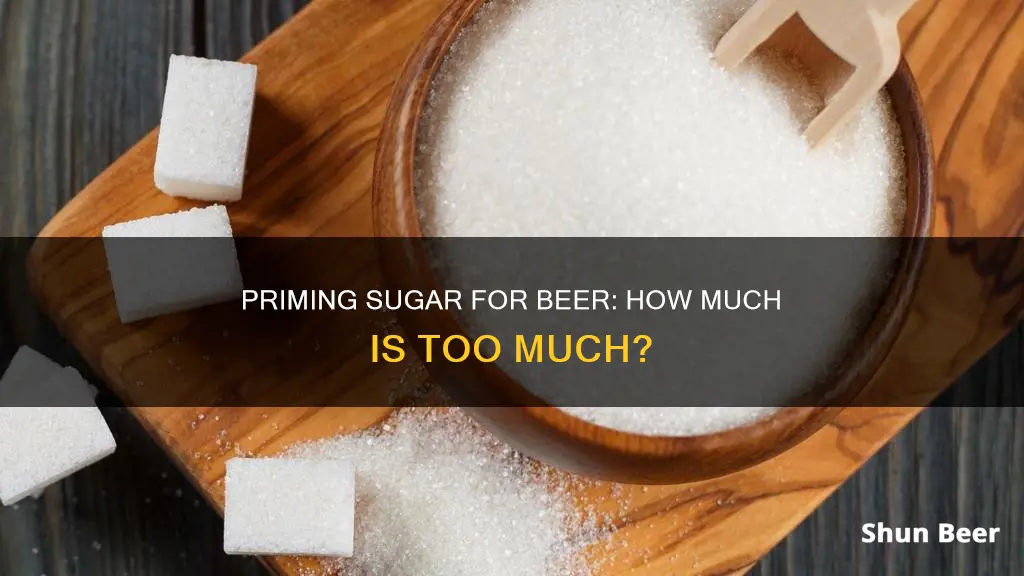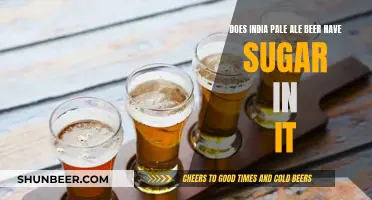
The amount of priming sugar you need for your beer depends on the type of sugar you're using and how carbonated you want your beer to be. For a standard level of carbonation, the rule of thumb is to use one ounce of corn sugar (aka dextrose) per US gallon of beer. If you're using table sugar (aka sucrose), reduce this figure by about ten percent. For a little less fizz, use three-quarters of an ounce of corn sugar per gallon.
| Characteristics | Values |
|---|---|
| How much priming sugar per gallon of beer | 1 ounce of corn sugar (dextrose) |
| How much priming sugar for 5 gallons of beer | 5 ounces of corn sugar (dextrose) |
| How much priming sugar for less carbonation | 3/4 ounce of corn sugar per gallon |
| How much table sugar for carbonation | 2/3 cup (5.3 ounces, or 150 grams) |
| How much light dry malt extract (DME) for carbonation | 1 1/4 cups (181 grams) |
What You'll Learn
- Corn sugar (dextrose) is a popular choice for priming beer as it doesn't influence the taste
- One ounce of corn sugar per US gallon of beer will give a nice level of carbonation
- Table sugar (sucrose) is a basic priming sugar that is low cost and easily available
- Dry malt extract (DME) is an unfermented wort that adds flavour and body to the beer
- Honey is a good option for meads or honey wine, but it can be difficult to work with

Corn sugar (dextrose) is a popular choice for priming beer as it doesn't influence the taste
Corn sugar, also known as dextrose, is a popular choice for priming beer. It is an extremely common ingredient in the brewing process. When used as a beer adjunct, dextrose can raise the alcohol content of a beer and reduce the body, which is excellent for high-gravity beers like Double IPA, Barley wine, or many Belgian beers.
Corn sugar is also widely used by hobby distillers to create a fermented sugar wash that can be distilled into whiskey or moonshine. It is highly refined and does not contain any corn character. Brewers seeking a corn-like character, for example in a classic American Pilsner, need to cook and mash corn grits as part of an all-grain recipe.
Corn sugar is a good choice for priming because it does not influence the taste of the beer. It is also about 95% solids, with 5% moisture, and the solids are about 99% glucose. This makes it a highly effective priming agent, as the remaining yeast will ferment the sugar to produce carbonation.
The amount of corn sugar needed for priming depends on the desired level of carbonation and the volume of beer being primed. A good rule of thumb is to use 3/4 cups (6 ounces or 113 grams) of corn sugar for every 5 gallons of beer. This will result in a carbonation level of about 2.5 volumes of carbon dioxide. For a lower carbonation level of about 2.0 volumes, 3 ounces (by weight) of corn sugar can be used, while 5 ounces will produce about 3.0 volumes.
It is important to note that a relatively high proportion of glucose in the wort (more than 15-20%) will inhibit the fermentation of maltose. Therefore, corn sugar should be added after primary fermentation has finished.
Shiner Beer: Sugar Content and Nutritional Facts
You may want to see also

One ounce of corn sugar per US gallon of beer will give a nice level of carbonation
Your beer is ready for bottling. You've waited for fermentation to complete, and now it's time to add priming sugar. The next step is to add priming sugar right before you bottle. The ideal amount of priming sugar is one ounce (by weight) of corn sugar (dextrose) per US gallon of beer, which will give a nice level of carbonation for most beers. This is a good rule of thumb to follow, and it's easy to remember.
Corn sugar is a great choice for priming sugar because it does not influence the taste of the finished beer. It's also very soluble and easy for the yeast to digest. You simply put it in some warm water, swirl it around, and it's ready to use. It's a popular option for home brewers and is widely available in pre-packaged amounts that are perfect for bottle carbonation.
How to Use Corn Sugar for Priming
To use corn sugar for priming, combine one ounce of corn sugar with 1.5 cups of water in a large pot. Bring it to a medium-high heat and stir until the sugar is completely dissolved. Then, boil the mixture for about five minutes. Remove it from the heat, cover it, and let it cool completely. Once it's cooled, you can transfer your beer from the fermenter into the pot with the priming solution and gently stir to combine. Now your beer is ready to bottle and will be perfectly carbonated!
Adjusting the Carbonation Level
If you want a little less carbonation in your beer, you can reduce the amount of corn sugar. Dropping it down to three-quarters of an ounce of corn sugar per gallon will give you a slightly lower level of carbonation. On the other hand, if you're looking for a higher level of carbonation, you can increase the amount of corn sugar slightly. Play around with the amounts to find the perfect level of carbonation for your taste preferences.
Benefits of Priming Sugar
Priming sugar is essential in the beer-making process because it provides food for the yeast, which creates carbonation. This carbonation, or effervescence, is carbon dioxide (CO2). As the yeast feeds on the sugar, it generates CO2, adding those beloved bubbles to your brew. While it's possible to drink beer without carbonation, priming sugar enhances the flavours and gives you that refreshing, bubbly beer experience.
Sugar in Pacifico Beer: What's the Sweet Truth?
You may want to see also

Table sugar (sucrose) is a basic priming sugar that is low cost and easily available
Table sugar, or sucrose, is a versatile and cost-effective option for priming beer. It is also known as "cane" sugar and can be easily found in supermarkets and grocery stores. It is a popular choice among homebrewers as it is inexpensive and readily available.
Table sugar can be used in place of corn sugar as a priming agent or as a wort constituent. It is 100% fermentable, which means that it will provide the necessary food for yeast to create carbonation in bottled beer. The carbonation process is essential to developing the best flavours and the refreshing zing in your beer.
The amount of table sugar required for priming depends on the volume of beer being brewed and the desired level of carbonation. For every five gallons of beer, the general rule of thumb is to use 2/3 cup (5.3 ounces or 150 grams) of table sugar. However, this amount can be adjusted to fine-tune the carbonation level to your preference.
When compared to other priming sugars, such as corn sugar (dextrose) and dry malt extract (DME), table sugar has the advantage of being widely available and affordable. It is also a consistent and reliable option for achieving the desired carbonation levels in homebrewed beer.
Some homebrewers have shared their positive experiences using table sugar for priming. They have reported improved carbonation and better results compared to other priming sugars. The convenience and ease of using table sugar make it a favourite among many brewers.
Beer and Blood Sugar: A Surprising Relationship
You may want to see also

Dry malt extract (DME) is an unfermented wort that adds flavour and body to the beer
The amount of priming sugar you need depends on the type of sugar used and the desired level of carbonation. For every five gallons of beer, the general rule of thumb is:
- 3/4 cups (6 ounces, or 113 grams) of corn sugar (dextrose)
- ⅔ cup (5.3 ounces, or 150 grams) of table sugar (sucrose)
- 1 1/4 cups (181 grams) of light dry malt extract (DME)
- 1/2 to 1 cup of honey
Dry malt extract (DME) is an unfermented wort that adds flavour and body to beer. It is created by removing the moisture content from liquid malt extract through a spray-drying process. This results in a malt product with a longer shelf life than its liquid counterpart. DME is typically used as a booster for kit beers, as it is easy to store and measure. It is also more temperature-tolerant and cost-effective than liquid malt extract.
DME comes in a variety of types, including light, pilsner, amber, dark, Bavarian wheat, and dried rice. The specific type of DME used depends on the style of beer being brewed. For example, pilsner DME is excellent for lagers, while Bavarian wheat DME is perfect for wheat beers.
When using DME as a priming sugar, it is important to consider its fermentability, also known as the limit of attenuation. This refers to the amount of material in the DME that yeast can digest and convert during fermentation. To ensure optimal quality, it is recommended to multiply the apparent fermentability by 0.82 to find the true fermentability.
CF + 0.5FTx (X/VB) = CB
Where:
- CF is the level of CO2 in your flat brew (in grams/litre)
- FT is the true fermentability of the DME
- X is the amount of DME (in grams)
- VB is the volume of your brew (in litres)
- CB is the carbonation level of your finished beer (in grams/litre)
Let's assume the American ale has a residual carbonation of 1.58 g/l, and the target carbonation level is 5.1 g/l. If the DME has an apparent fermentability of 75%, the true fermentability would be 0.75 x 0.82 = 0.615 or 61.5%. Using the standard amount of 1 1/4 cups (181 grams) of DME, we get:
58 + 0.5 (0.615(181/19)) = 4.5 g/l or 2.30 volumes
Since this carbonation level is lower than the target, we can adjust the amount of DME to 215 grams to achieve the desired carbonation level:
58 + 0.5 (0.615(215/19)) = 5.1 g/l or 2.58 volumes
Stout Beer Sugar Content: What You Need to Know
You may want to see also

Honey is a good option for meads or honey wine, but it can be difficult to work with
Honey is a good option for meads or honey wine but it can be difficult to work with. Meads, or honey wines, are one of the oldest alcoholic drinks known to man, with origins as far back as 5,000 years in Asia and Africa. The Vikings are most well-known for drinking mead, but it was also found in ancient cultures across the world.
Honey is made up of approximately 70% sugar, which is the food source for the yeast to produce alcohol. The amount of honey you use will determine the sweetness of your mead, so if you use a little honey, the wine will be dry, and if you use a lot of honey, it will be sweet. You can also add more sugar, like corn sugar, to increase the sweetness.
There are many varieties of honey, each with its own unique qualities, derived from the nectar of the flowering blossom of each type of plant. For example, some honeys are gulden yellow, while others are coppery brown. The type of honey you use will give your mead its unique flavour, colour, and taste. While yeast contributes some character, and oaking and temperature of fermentation will also have an effect, honey is the foundation of all mead flavours.
When choosing honey, it is recommended to avoid supermarket filtered, pasteurized, bulk honey, and instead opt for a raw, varietal honey such as sage or raspberry. This will impart a much more desirable flavour and aroma to your product. It is also important to note that mead honey should not be pasteurized or heated, but filtered is acceptable as it removes bee particles, wings, antennae, twigs, and leaves.
Making mead can be a lengthy process, and it is recommended to make a large batch as it needs to sit in the bottle for months, if not years. A one-gallon batch will only make five 750ml wine bottles of mead, and you will likely drink these within the first 12 months. A five-gallon batch, on the other hand, will give you 12 bottles to drink in the first two years, and 12 bottles to savor for special occasions.
Goldberg Beer: Sugar Content and Nutritional Facts
You may want to see also
Frequently asked questions
1 ounce of priming sugar per gallon of beer will give you a nice level of carbonation for most beers.
This is the measurement for corn sugar (dextrose). If you are using table sugar (sucrose), you need to reduce the amount by about 10%.
You will need 5 ounces of priming sugar for a 5-gallon batch.
Combine 5 ounces (2/3 cup) of priming sugar with 2 cups of water in a large pot. Bring to medium-high heat, stirring to dissolve the sugar. Boil for 5 minutes, then remove from heat, cover, and let cool completely.
You should add the priming sugar to your beer after fermentation is complete and right before bottling.







